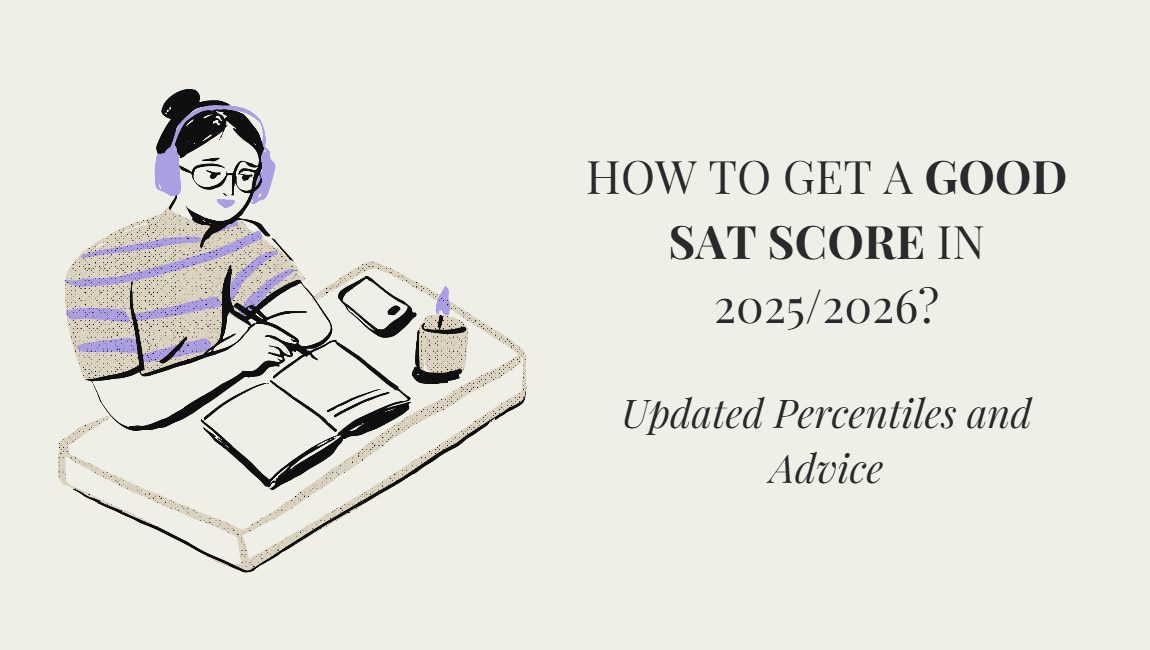You’ve probably thought about what is a good SAT score in 2025-2026 if you’re serious about applying to college. A lot of schools are now test-optional, but the scores you get are still very important for admissions decisions, scholarships, and even course placement.
So, this guide covers what really matters: updated percentiles, competitive scores, and simple prep tips to help you walk into test day confident and ready.
How Is the SAT Scored?
The total score ranges from 400 to 1600, split between two main sections: Math and Reading and Writing. Each section contributes up to 800 points. You can generally expect your SAT results about 2–4 weeks after your test date.
Every correct answer earns points, and your raw scores are converted into scaled scores using the College Board formula. That way, your final score shows how you did compared to everyone else. And you’ll also see a percentile that tells you what percent of test-takers scored lower than you.
For example, if you score in the 80th percentile, you performed better than 80% of students who took the test. These numbers help you see where you stand academically.
By 2025, the SAT is fully digital worldwide. It’s now shorter (a little over 2 hours now) and adaptive, meaning the difficulty of later questions changes based on how you do earlier. The scoring scale in the digital SAT hasn’t changed, so a 1400 still means what it did before.
What Is a Good SAT Score?
In general, a good SAT score is one that helps you stand out among applicants to your target schools. The truth is, it depends on where you want to apply, but here’s a quick way to think about it:
- Around 1200 is considered a good score on the SAT, putting you in roughly the top 25% of all test takers.
- A 1400 or above is great, landing you in the top 7% or so.
- And a 1500 or above is excellent, ranking in the top 2% nationwide.
So, scores above 1200 are above average, while 1350–1450 are strong for most selective universities. Anything above 1500 is considered competitive for Ivy League schools and top-tier programs.
According to the College Board, for 2025, the average SAT score is about 1029 total.
At the same time, college-readiness benchmarks are a 480 Reading score and a 530 Math section score. College admissions use all these numbers when reviewing applications.

What Are the SAT User Percentiles for 2025/2026?
These percentiles for total scores help you understand how your results stack up nationally.
| Total Score | Percentile | Total Score | Percentile |
| 1600 | 99+ | 1200 | 76 |
| 1550 | 99 | 1150 | 70 |
| 1500 | 98 | 1100 | 63 |
| 1450 | 96 | 1050 | 56 |
| 1400 | 93 | 1000 | 48 |
| 1350 | 90 | 950 | 41 |
| 1300 | 86 | 900 | 33 |
| 1250 | 82 | 850 | 25 |
Worth noting that percentiles change slightly every year because they’re based on the performance of the most recent three graduating classes. The College Board updates them annually, so the numbers above are the most current and accurate for this admissions cycle.
Also, if you already have your target schools in mind, comparing your score to their middle-50% range will help you see exactly how close you are to your goal.
Now, let’s take a close look at the percentiles by section.
| Section score | Reading and Writing Percentile | Math Percentile |
| 800 | 99+ | 99+ |
| 750 | 98 | 96 |
| 700 | 93 | 92 |
| 650 | 85 | 85 |
| 600 | 74 | 77 |
| 550 | 61 | 66 |
| 530 | 55 | 60 |
| 500 | 45 | 51 |
| 480 | 39 | 46 |
| 450 | 30 | 37 |
| 400 | 16 | 22 |
If you’ve looked closely at the numbers, you’ll notice the Math percentiles are slightly tougher than Reading and Writing. That’s because more students score higher on Math overall, which makes each additional point count for less movement in percentile rank.
For example, a 700 in Math puts you around the 92nd percentile, while a 700 in Reading and Writing lands closer to the 93rd.
What this means for you: Don’t stress if your Math score seems harder to raise percentile-wise. Even small increases (like 20–30 points) can push you up more than you expect in the total composite.
Just so you know, colleges primarily use percentiles for total scores, not sections, when they talk about admitted student ranges and compare applicants. At the same time, admissions officers still see your section scores, but they’re mainly used for context. For instance, a high Math and slightly lower Reading score might still look great for an engineering program.
How to Get a Good Score on the SAT?
Now, let’s talk about how to get there. You need to put in some strategic thinking, regular work, and clever planning to raise your test scores.
Set Your Target Score
First, take a quick look at what SAT scores your favorite colleges usually accept.
Here are the middle 50% SAT totals for top U.S. colleges, based on their latest Common Data Set and official admissions data.
| College | Total SAT Score (Middle 50%) |
| Harvard University | 1510–1580* |
| MIT | 1520–1570 |
| Yale University | 1480–1560 |
| Princeton University | 1500–1560 |
| Georgia Tech | 1370–1530 |
| University of Michigan (Ann Arbor) | 1360–1530 |
| UNC–Chapel Hill | 1400–1530 |
| University of Virginia | 1410–1520 |
| University of Florida | 1330–1470 |
| USC (University of Southern California) | 1450–1550* |
| Boston University | 1430–1510 |
| Northeastern University | 1450–1520 |
*Calculated from section percentiles (Reading + Math) when the Common Data Set listed sections, but not a composite band.
Once you know the average range, aim a little higher. A good rule of thumb is to try setting your personal goal about 20–30 points above that number. It gives you something to reach for without feeling impossible.
Create a Smart Study Plan
It’s better to start early (ideally during your junior year). In 10th or 11th grade, you can take the PSAT. It’s basically the practice SAT that shows where you currently stand and what areas need work.
Many students use their PSAT scores to spot weak sections months before the real test. Plus, if you score high enough, you could qualify for the National Merit Scholarship, which looks great on college applications.
To achieve the best results, break your study for the SAT into three stages:
- Break down the basics. Focus on understanding types of questions and content.
- Practice regularly. Take full-length practice tests under timed conditions.
- Review and refine. Go through your score report, identify mistakes, and fix weak areas.
Remember, even one focused hour a day can make a huge difference over time.
And when you prepare for the SAT, stick only with reliable resources. For example, the College Board’s Bluebook App and Khan Academy offer official SAT practice tests.
You can also add a few trusted prep books like The Princeton Review or Barron’s SAT to mix digital and print practice, which keeps your brain flexible.
Strengthen Each Section
To improve your SAT score, obviously, you must strengthen each section.
When you practice reading passages, don’t stress about every detail. Just focus on the main idea, the author’s tone, and the evidence that backs it up. For the writing part, brush up on basic grammar, punctuation, and sentence flow.
As for math questions, go over the basics like algebra, data analysis, and problem-solving. Keep those key formulas fresh in your mind, and practice solving problems fast and try a few without a calculator so you’re ready for anything on test day.
Oh, and here’s something important: many students have a clear, strong side and a weaker one. So, if math stresses you out, it’s better to start there, for sure.
Master Time Management
The best way to start is by timing your practice SAT tests and getting a real sense of how fast you need to move. But during the exam, be attentive and don’t spend too long on one tricky question. If you’re stuck, skip it and come back later.
Try to get into a beat too. For instance, check in with yourself every 10 minutes to see if you’re still on track. This kind of small habit helps you stay calm and on task. The goal is not to finish the test early, but to make good use of your time.
As an aside, taking at least three full practice exams under timed conditions will help you get the pacing and dramatically increase your SAT score.
Should You Retake the SAT to Improve Your Score?
If your score isn’t quite where you want it to be, retaking the SAT can definitely be worth it. Many students see their scores go up the second time—mostly because they already know what to expect and feel less nervous.
Technically, there’s no limit, and you can take the SAT as many times as you would like. That said, most students take it two or three times at most. The first attempt is often about getting used to the format, while the second (and sometimes third) is where they aim for their target score.
A quick FYI: the standard registration fee for the SAT now is $68 in the U.S., and for international test-takers, there’s an extra fee of $43.
It’s also good to know that many colleges use “superscoring,” which means they combine your best section scores from different test dates. So even if you retake it, every effort can count toward your highest possible total.
How Hard Would It Be to Get a Perfect 1600 on the SAT?
Getting a perfect SAT score is seriously tough. Less than 1% of students pull it off each year, and basically, you’d be beating 99% of already high-scoring test-takers.
If you’re a high school student aiming high, you’ll need a plan. That’s because all perfect scorers treat SAT prep like a routine—consistent and intentional, not random cramming the week before.
Students who get a high score usually tend to handle the SAT a bit differently:
- Know the test well. The timing, question styles, and patterns should start to feel familiar, almost like second nature.
- Use mistakes to your advantage. Every wrong answer is just another way to figure out what to fix next time.
- Keep your cool. Staying calm on test day can help just as much as knowing the material.
- Keep a good balance. Get enough sleep, take breaks, and stay healthy — it all adds up more than you think.
These tips come straight from some of the best college admissions consultants who’ve helped hundreds of students hit top scores.
Sure, the road to perfection is demanding, but it’s not out of reach. And remember that even a 1550 already puts you in the top percentile of students nationwide.
Wrapping Up
At the end of the day, your SAT score is just one part of your college application. Your GPA, essays, extracurricular activities, and personal narrative are all very important to admissions officers.
A good score will help you, but it won’t decide your future. The most important thing is to show who you are. So, focus on doing your best on the SAT, but don’t forget to put the same effort into the rest of your application. That’s what truly makes you stand out in the college admission process.

